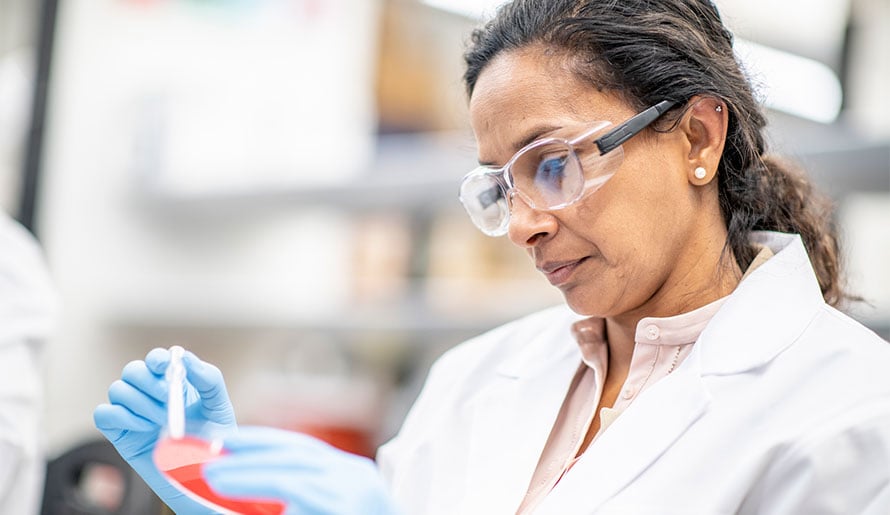Saturation Biopsy

A saturation biopsy can be used to help diagnose a patient with prostate cancer. Designed to retrieve more tissue samples from a tumor site than a standard biopsy, this option provides pathologists with a more extensive selection of cells to test for the presence of cancer.
Whereas a standard biopsy typically retrieves just 12 to 14 tissue samples, a saturation biopsy can retrieve 20 or more samples at one time. This, in turn, yields several benefits, such as:
- Improved sampling of the anterior zone of the prostate gland, where cancer can otherwise go undetected.
- Improve detection of small tumors missed on traditional 12-core systematic biopsy.
- Improved ability to identify tumors that are eligible for cryoablation therapy.
To perform a saturation biopsy, a surgeon will insert a needle through the perineum while the patient is under general anesthesia in an operating room. The needle will then be used to carefully remove a selection of cells from various locations throughout the prostate.
Saturation biopsy recovery tips
Recovery times and complication rates are similar (and typically minimal) for both saturation and conventional biopsies. Following a prostate biopsy, the patient's physician will typically recommend only light activity for 24 to 48 hours. The physician may also prescribe an antibiotic to take for a few days. Slight soreness and light bleeding might be experienced from the rectum, and there could also be a small amount of blood noticeable in the patient’s urine, stools, or semen for several weeks. Some patients may experience difficulty emptying their bladder due to swelling of the prostate. So, a catheter may be in place for a few days.
Note that a saturation biopsy is not recommended for most patients. Your doctor will discuss the best treatment option with you.
Prostate cancer diagnosis at Moffitt Cancer Center
At Moffitt Cancer Center, the saturation biopsy is just one of the diagnostic prostate cancer procedures that we use. A multispecialty team will assess each patient’s needs to determine which lab tests are most likely to result in a prompt and accurate diagnosis.
Regardless of the technique used to obtain a tissue sample, our pathologists are highly skilled at detecting signs of cancer in prostate specimens. Because our biopsies are completed and analyzed in the same location, we can accelerate the evaluation process and quickly place our patients on the path to proper treatment.
Medically reviewed by Alice Yu, MD.
To learn more about a saturation biopsy or any of the other diagnostic techniques that we use to detect and grade prostate cancer, call 1-888-663-3488 or fill out our new patient registration form online.
Prostate Cancer
- Adrenal Cancer
- Anal Cancer
- Appendiceal (Appendix) Cancer
- Astrocytoma
- Basal Cell Carcinoma
- Bladder Cancer
- Bone Metastasis
- Brain Cancer
- Brain Tumor
- Breast Cancer
- Cervical Cancer
- Cholangiocarcinoma (Bile Duct Cancer)
- Colon Cancer
- Colorectal Cancer
- Cutaneous Lymphoma (CTCL)
- Ductal Carcinoma In Situ
- Endometrial (Uterine) Cancer
- Esophageal Cancer
- Gallbladder Cancer
- Gastrointestinal Carcinoid Tumor
- GIST (Gastrointestinal Stromal Tumor)
- Glioblastoma
- Head and Neck Cancer
- HER2 Positive Breast Cancer
- Hodgkin Lymphoma
- Inflammatory Breast Cancer
- Invasive Ductal Carcinoma
- Kidney (Renal Cell) Cancer
- Leukemia
- Liver (Hepatocellular) Cancer
- Low-Grade Glioma
-
Lung Cancer
- Signs and Symptoms
- Diagnosis
- Treatment
- FAQs
- Lung Cancer Early Detection Center
- Lung Cancer Screening and Surveillance Program
- Lung Nodules
- Lung Surveillance Clinic
- Metastatic Lung Cancer
- Recurrence
- Survival Rate
- Your Lung Cancer Specialists
- Lung and Thoracic Tumor Education (LATTE)
- Thoracic Clinic Updates
- Insurance & Financial Information
- Lymphomas (Hodgkin and Non-Hodgkin)
- Melanoma
- Meningioma
- Merkel Cell Carcinoma
- Mesothelioma
- Metastatic Breast Cancer
- Multiple Myeloma-Plasma Cell Tumor
- Myelodysplastic Syndromes (MDS)
- Neuroendocrine Tumor
- Neurofibromatosis
- Non-Hodgkin Lymphoma
- Oral Cavity (Mouth) Cancer
- Oral Cavity or Throat Cancer
- Osteosarcoma
- Ovarian Cancer
- Pancoast Tumor
- Pancreatic Cancer
- Penile Cancer
- Pituitary Adenoma
- Prostate Cancer
- Rectal Cancer
- Sarcoma
- Skin Cancer (Nonmelanoma)
- Skull Base Tumors
- Small Intestine Cancer
- Spinal Tumor
- Squamous Cell Carcinoma
- Stomach (Gastric) Cancer
- Testicular Cancer
- Throat Cancer
- Thymoma
- Thyroid Cancer
- Tongue Cancer
- Tracheal Cancer
- Triple Negative Breast Cancer
- Vaginal Cancer
- Vulvar Cancer
